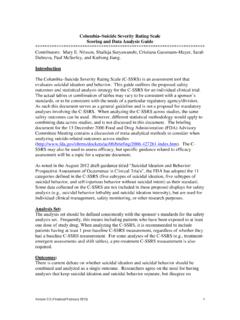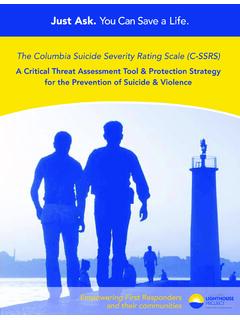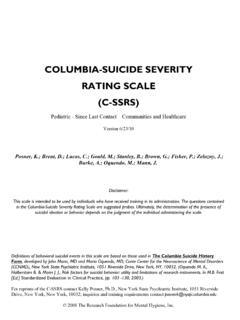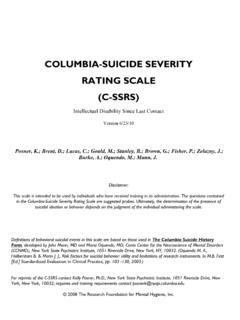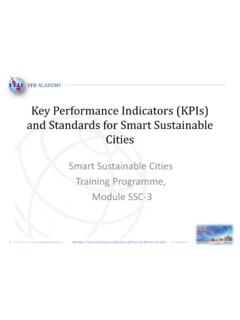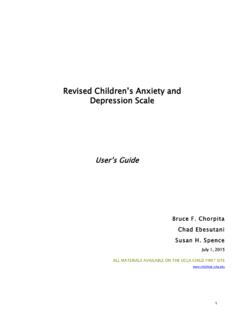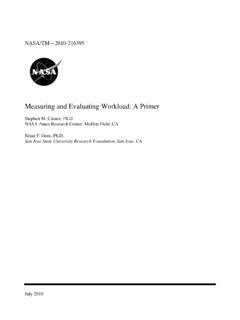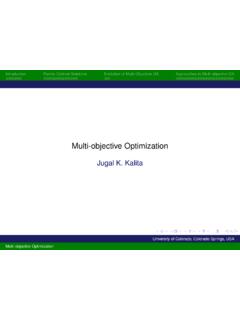Transcription of Columbia Suicide Severity Rating Scale Scoring and Data ...
1 Columbia Suicide Severity Rating Scale Scoring and Data Analysis Guide **. Contributors: Mary E. Nilsson, Shailaja Suryawanshi, Cristiana Gassmann-Mayer, Sarah Dubrava, Paul McSorley, and Kaihong Jiang. Introduction The Columbia Suicide Severity Rating Scale (C-SSRS) is an assessment tool that evaluates suicidal ideation and behavior. This guide outlines the proposed safety outcomes and statistical analysis strategy for the C-SSRS for an individual clinical trial. The actual tables or combination of tables may vary to be consistent with a sponsor's standards, or to be consistent with the needs of a particular regulatory agency/division. As such this document serves as a general guideline and is not a proposal for mandatory analyses involving the C-SSRS. When analyzing the C-SSRS across studies, the same safety outcomes can be used. However, different statistical methodology would apply to combining data across studies, and is not discussed in this document.
2 The briefing document for the 13 December 2006 Food and Drug Administration (FDA) Advisory Committee Meeting contains a discussion of meta-analytical methods to consider when analyzing Suicide -related outcomes across studies ( ). The C- SSRS may also be used to assess efficacy, but specific guidance related to efficacy assessment will be a topic for a separate document. As noted in the August 2012 draft guidance titled Suicidal Ideation and Behavior: Prospective Assessment of Occurrence in Clinical Trials , the FDA has adopted the 11. categories defined in the C-SSRS (five subtypes of suicidal ideation, five subtypes of suicidal behavior, and self-injurious behavior without suicidal intent) as their standard. Some data collected on the C-SSRS are not included in these proposed displays for safety analysis ( , suicidal behavior lethality and suicidal ideation intensity), but are used for individual clinical management, safety monitoring, or other research purposes.
3 Analysis Set: The analysis set should be defined consistently with the sponsor's standards for the safety analysis set. Frequently, this means including patients who have been exposed to at least one dose of study drug. When analyzing the C-SSRS, it is recommended to include patients having at least 1 post-baseline C-SSRS measurement, regardless of whether they had a baseline C-SSRS measurement. For some analyses of the C-SSRS ( , treatment- emergent assessments and shift tables), a pre-treatment C-SSRS measurement is also required. Outcomes: There is current debate on whether suicidal ideation and suicidal behavior should be combined and analyzed as a single outcome. Researchers agree on the need for having analyses that keep suicidal ideation and suicidal behavior separate, but disagree on Version (Finalized February 2013) 1. whether there is value to having any outcome that combines them.
4 This document currently includes the combined outcomes measure. The following outcomes are C-SSRS categories and have binary responses (yes/no). The categories have been re-ordered from the actual Scale to facilitate the definitions of the composite and comparative endpoints, and to enable clarity in the presentation of the results. Category 1 Wish to be Dead Category 2 Non-specific Active Suicidal Thoughts Category 3 Active Suicidal Ideation with Any Methods (Not Plan) without Intent to Act Category 4 Active Suicidal Ideation with Some Intent to Act, without Specific Plan Category 5 Active Suicidal Ideation with Specific Plan and Intent Category 6 Preparatory Acts or Behavior Category 7 Aborted Attempt Category 8 Interrupted Attempt Category 9 Actual Attempt (non-fatal). Category 10 Completed Suicide Self-injurious behavior without suicidal intent is also a C-SSRS outcome (athough not Suicide -related) and has a binary response (yes/no).
5 The following outcome is a numerical score derived from the C-SSRS categories. The score is created at each assessment for each patient and is used for determining treatment emergence. Suicidal Ideation Score: The maximum suicidal ideation category (1-5 on the C- SSRS) present at the assessment. Assign a score of 0 if no ideation is present. Endpoints: Composite endpoints based on the above categories are defined below. Suicidal ideation: A yes answer at any time during treatment to any one of the five suicidal ideation questions (Categories 1-5) on the C-SSRS. Suicidal behavior: A yes answer at any time during treatment to any one of the five suicidal behavior questions (Categories 6-10) on the C-SSRS. Suicidal ideation or behavior: A yes answer at any time during treatment to any one of the ten suicidal ideation and behavior questions (Categories 1-10) on the C-SSRS.
6 comparative endpoints of interest are defined below. Treatment emergence is used for outcomes that include events that first emerge or worsen. Emergence is used for outcomes that include events that first emerge. Version (Finalized February 2013) 2. Treatment-emergent suicidal ideation compared to recent history: An increase in the maximum suicidal ideation score during treatment from the maximum suicidal ideation category during a specified pre-treatment period (C-SSRS scales taken during the specified pre-treatment period; excludes lifetime scores from the Baseline C-SSRS Scale or Baseline/Screening C-SSRS Scale ). Treatment-emergent serious suicidal ideation compared to recent history: An increase in the maximum suicidal ideation score to 4 or 5 on the C-SSRS during treatment from not having serious suicidal ideation (scores of 0-3) during a specified pre-treatment period (C-SSRS scales taken during the specified pre- treatment period; excludes lifetime scores from the Baseline C-SSRS Scale or Baseline/Screening C-SSRS Scale ).
7 Emergence of serious suicidal ideation compared to recent history: An increase in the maximum suicidal ideation score to 4 or 5 on the C-SSRS during treatment from no suicidal ideation (scores of 0) during a specified pre-treatment period (C- SSRS scales taken during the specified pre-treatment period; excludes lifetime . scores from the Baseline C-SSRS Scale or Baseline/Screening C-SSRS Scale ). Improvement in suicidal ideation at a time point of interest compared to baseline: An improvement in this endpoint can be considered as a decrease in suicidal ideation score at the time point of interest ( , the last measurement during treatment) from the baseline measurement ( , the measurement taken just prior to treatment. This analysis should only be performed for studies in which a baseline C-SSRS can be defined ( , having improvement from the worse event over a lifetime is not clinically meaningful).)
8 Emergence of suicidal behavior compared to all prior history: The occurrence of suicidal behavior (Categories 6-10) during treatment from not having suicidal behavior (Categories 6-10) prior to treatment (includes lifetime and/or screening scores from the Baseline C-SSRS Scale , Screening C-SSRS Scale , or Baseline/Screening C-SSRS Scale , and any Since Last Visit from the Since Last Visit C-SSRS scales taken prior to treatment). Additional comparative endpoints for consideration are defined below. These are not necessarily recommended for all treatment programs, but if used, should follow the nomenclature. Treatment-emergent suicidal ideation compared to all prior history: An increase in the maximum suicidal ideation score during treatment from the maximum suicidal ideation score prior to treatment (includes lifetime and/or screening . scores from the Baseline C-SSRS Scale , Screening C-SSRS Scale , or Baseline/Screening C-SSRS Scale , and any Since Last Visit from the Since Last Visit C-SSRS scales taken prior to treatment).
9 Version (Finalized February 2013) 3. Emergence of serious suicidal ideation compared to all prior history: An increase in the maximum suicidal ideation score to 4 or 5 during treatment from no suicidal ideation (scores of 0) prior to treatment (includes lifetime and/or screening scores from the Baseline C-SSRS Scale , Screening C-SSRS Scale , or Baseline/Screening C-SSRS Scale , and any Since Last Visit from the Since Last Visit C-SSRS scales taken prior to treatment). Treatment-emergent serious suicidal ideation compared to all prior history: An increase in the maximum suicidal ideation score to 4 or 5 on the C-SSRS during treatment from not having serious suicidal ideation (scores of 0-3) prior to treatment (includes lifetime and/or screening scores from the Baseline C- SSRS Scale , Screening C-SSRS Scale , or Baseline/Screening C-SSRS Scale , and any Since Last Visit from the Since Last Visit C-SSRS scales taken prior to treatment).
10 Outcomes that can be used for clinical management and safety monitoring or potentially for research purposes are described below. Suicidal behavior lethality Rating taken directly from the C-SSRS. Suicidal ideation score Any score greater than 0 is important and may indicate the need for mental health intervention. The protocol procedures related to clinical care of patients with treatment emergent suicidal ideation and behaviors will then be implemented to ensure proper management of the event and protection of the patient's safety. For example, a score of 4 (active suicidal ideation with some intent to act) or 5 (active suicidal ideation with specific plan and intent) on suicidal ideation can be used to indicate serious suicidal ideation and can be used to trigger further evaluation and immediate contact with patient's mental health practitioner (for non-psychiatry trials this may be used to trigger a prompt referral to a mental health professional).
